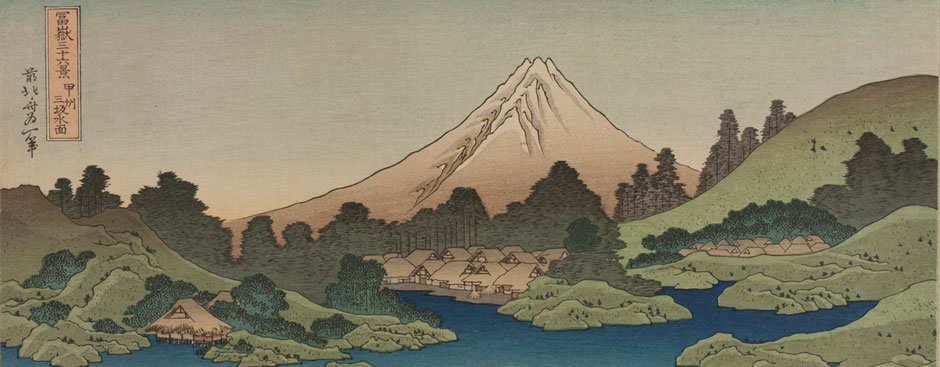The Lake at Misaka in the Province of Kai
Justin Toran-Burrell, Swarthmore College, Class of 2014
The Lake at Misaka in the Province of Kai is one of thirty-six woodblock prints from Katsushika Hokusai's series Thirty-six Views of Mount Fuji, which includes the famous Great Wave off Kanagawa, a foremost icon of Japanese visual culture.
This particular ukiyo-e print depicts a small village located on the calm waters of Lake Kawaguchi, just west of Tokyo. The village sits at the base of Mt. Fuji, whose rugged northern face is seen in the distance. The village is nestled in the forest - represented here by dark green vegetation - which reaches the footholds of the mountain. Only a small boat headed toward the bay disrupts the calm, serene feel of Lake Kawaguchi.
Commercial woodblock printing in Japan arose during the 17th century. Prints are created by carving an image onto a woodblock, inking it, and rubbing the surface of the paper placed over it, with different blocks being used for each color. Ukiyo-e, or "pictures of the floating world," were meant to represent the transient everyday life experienced by dwellers of Edo (present day Tokyo). Hokusai and his contemporary Hiroshige were especially known for their extensive use of landscapes, which had not been a focal subject of woodblock printing before these two began to create iconic views of notable sites and spots in Japan.
While known for his different styles of printmaking and painting, Hokusai was also known for his vivid use of color, which is evident from looking at any of the prints in the Thirty-six Views of Mount Fuji. In this print, the hills surrounding the village are a lighter green, with small dots of emerald placed throughout to denote trees. The forest surrounding the village consists of taller emerald trees that distinguish the hills from the foliage. The mountain is mostly golden, denoting the rocky slope of Mt. Fuji. As the mountain ascends, the gold lightens until it is almost white at the peak, in contrast to the light-blue sky. The top of the print is a darker Prussian blue, which Hokusai was recognized for using before his contemporaries. The water is a similar light blue of the sky; it is however broken up by the reflection of Fuji in the water. Fuji's reflection does not truly reflect the nature of the mountain above; it is depicted in the water as mostly grey with a white, snow-capped peak. The fishing boat and the thatched roofs of the houses share the same golden color that was used to illustrate Fuji. Hokusai utilizes these lush, rich colors to represent a seasonal change between the warm summer depicted here and the cooler winter months seen in many of his other prints.
Most of the other views in Hokusai's series depict similar views of Fuji, with its snow-capped peak easily visible and instantly recognizable. This view from Lake Kawaguchi offers a slightly different view. Lake Kawaguchi lies west of Tokyo and to the north of Mt. Fuji, giving observers a look at Fuji's northern face. Hokusai renders a naturalistic portrayal of Fuji's northern side, in contrast to the snowcapped mountain familiar in traditional Fuji images. The mountain's rugged terrain also serves as an informative indicator of the season; the lack of snow on the mountain suggests a warmer summer season. The sprawling green hills is a reinforcement of the season. Hokusai represented all four seasons in his Fuji series; depicting Fuji this way may have been his way of telling the viewer that this time of year is distinct from others in his works.
Interestingly, Fuji's uncovered, rocky face is not reflected back in the water. The Fuji that the viewer sees in the reflection of Lake Kawaguchi is a more familiar snow-peaked one, which can be seen in many of Hokusai's other works. This reflection serves multiple purposes. Having the dark grey mountain and its snow-covered peak reflecting in Lake Kawaguchi further emphasizes the seasonal differences, by contrasting a winter Fuji with a summer one. It also reflects directional differences in Fuji's composition; while many images of Fuji are seen from its eastern face (which is the face that can be seen from Tokyo), this view offers a different angle of the mountain, and perhaps a less known one. Hokusai intentionally uses a false reflective image to draw the viewer into the image and engage with what they're seeing - a different reflection prompts the viewer to look and compare the two contrasting images and serves as a focal point to which the viewer draws his or her attention. It is interesting to note that the reflection of the mountain in Lake Kawaguchi is off center, which serves to create a sense of balance within the image.
Another piece in this exhibit serves as a point of reference for this print and the directional differences when viewing Fuji from multiple sides. In Fujiyama from Motosu Lake the observer gets a view of Mount Fuji's Northeastern face from Motosu Lake. This lantern slide offers a photographic rendition of the view from across the lake, and thus a realistic representation of the mountainside.
One of the special features allowed by woodblock printing is the ability to create multiple works from one combination of blocks in many different shades and colors. Woodblock prints were a much more accessible art form for the middle and working class members of Japanese society; because of their mass-production capabilities, they were less expensive than other traditional forms of Japanese art.

